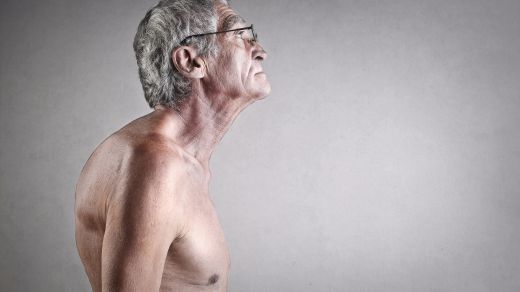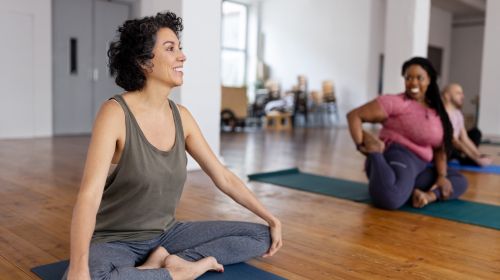The widow’s hump is more than just a visual problem. Hunching on the back can lead to severe back pain and other impairments. You can read here how a hunched back occurs, who is affected and whether it can be prevented.
- © olly – stock.adobe.com
Quick overview: Frequently asked questions and answers about the widow’s hump
What is a widow’s hump? A widow’s hump is a pathological curvature of the thoracic spine in which a visible hump forms below the neck.
What symptoms occur? The main symptom is the formation of humps. This can be accompanied by pain and restricted movement.
What to do about widow’s hump? A widow’s hump is primarily treated conservatively. With appropriate therapy, regression is only possible in children and adolescents.
Can widow’s hump be prevented? For healthy people, it is possible to prevent widow’s hump with good posture and strong back muscles.
Article content at a glance:
What is a widow’s hump?
A widow’s hump is a severe curvature of the thoracic spine (hyperkyphosis) caused by illness.
Widow’s Hump is often a result of osteoporosis or poor posture and can cause problems such as back pain and breathing problems. However, the symptoms can be alleviated with exercises and physiotherapy.
However, if it increases in this area and becomes a hump, it is called pathological kyphosis, also known as hyperkyphosis or hunchback.
Who gets a widow’s hump?
Hyperkyphosis does not primarily affect older women, which is why the disease is colloquially called widow’s hump.
However, a hunched back can also occur in men and at any age. For example, hyperkyphosis also occurs in adolescents due to poor posture.
Symptoms of widow’s hump
Hyperkyphosis can cause various symptoms ranging from mild to severe. The most characteristic sign is the visible, excessive deformation of the upper spine, resulting in a hunched back. In addition, other symptoms may occur such as:
severe back pain
radiating pain in the head, neck, arms and legs
limited mobility, especially with rotational and sideways movements of the spine. An upright posture is almost impossible
painful shortening and tension of the muscles along the spine
Breathing problems when the lungs have less room to expand
Changed gait due to a strongly bent posture
People with hyperkyphosis also often suffer from their appearance. This can also lead to psychological problems such as depression.
A widow’s hump should not be confused with a bull’s neck. This is an increase in fatty tissue in the neck, which occurs primarily in connection with obesity.
Treatment: What to do if you have widow’s hump?
Treatment for widow’s hump depends on various factors, such as the cause, severity, age of those affected and any accompanying symptoms.
In most cases, treatment is initially conservative with physiotherapy. This is intended to strengthen the muscles in the chest, back and abdominal areas and relieve the strain on the spine.
Those affected also learn exercises that they should carry out independently at home. The exercises cannot train away the widow’s hump, but they can prevent the hump from progressing and possible stiffening of the spine.
In addition, those affected are taught breathing exercises that can increase the breathing volume and thereby counteract breathing problems such as shortness of breath.
Physiotherapists can also advise on the optimal sleeping position if you have a curvature of the spine. If necessary, additional ergonomically shaped pillows can support the sleeping position and thus a restful and pain-free sleep.
Painkillers and surgery for hyperkyphosis
For some patients, a specially made corset, a so-called orthosis, can help stabilize the back and prevent the hyperkyphosis from worsening. In children and adolescents, hunching can even be corrected with the help of orthoses.
If necessary, painkillers or anti-inflammatory medications will also be prescribed to relieve pain associated with hyperkyphosis.
If conservative therapy does not lead to improvement, surgery may be considered. This particularly affects people in whom hyperkyphosis progresses and causes significant pain or breathing problems.
The operation can correct and stabilize the vertebrae. However, a surgical procedure is always associated with risks and side effects. These and the advantages of surgery should be discussed in detail with the treating doctor beforehand.
Causes of a widow’s hump
Excessive backward curvature of the spine can have various causes. In older people it often occurs as a result of osteoporosis. In this disease, bone density decreases significantly, making the vertebral bodies more susceptible to deformation and vertebral fractures. This can cause the back to deform and form a hump at the level of the thoracic spine.
Other possible causes are:
habitual bad posture: A careless or constantly hunched posture, for example at work, at a desk or on a cell phone, can promote a hunchback. Especially in combination with weak abdominal and back muscles.
age-related changes: With increasing age, changes to the spine can occur, for example due to the vertebral bodies collapsing. This can contribute to hump formation.
Scheuermann’s disease: Scheuermann disease is a growth disorder in adolescents. The vertebrae in the thoracic spine grow unevenly, which leads to a curvature of the spine.
congenital malformation: Some people are born with malformations that can lead to hyperkyphosis.
In addition, fractures, tumors or inflammatory rheumatic diseases such as Bechterew’s disease can also promote the development of a hunched back.
How can widow’s hump be prevented?
Good posture and a strong back not only prevent back pain, but can also prevent postural problems such as a hunched back from developing. This can be supported with various measures:
movement and sport: Regular physical activities, stretching and sports generally help to strengthen the muscles of the body and keep the spine flexible. This is possible with simple activities such as walking or hiking. In addition, exercises can strengthen the back muscles and improve posture.
Stretch regularly: Stretching exercises counteract tension and muscle shortening, which often occurs in the neck and chest muscles due to a hunched posture. Helpful sports include yoga and Pilates. They promote flexibility, improve posture and can prevent posture problems.
Pay attention to posture: Conscious attention should be paid to posture in everyday life. It is advisable to often take your shoulders back and keep your back straight, especially when sitting and standing.
Ergonomic workplace: A well-equipped workplace can prevent back pain and poor posture, especially if a lot of time is spent at a desk. What is important is the correct seat height, the distance to the screen and the position of the chair.
Conscious sitting and standing: Sitting or standing in a rigid position for long periods of time should be avoided. Changing your posture, consciously sitting up, taking breaks and short stretching exercises can be helpful.
Back-friendly sleeping position: A good mattress and the correct sleeping position support the natural curvature of the spine during sleep. The most gentle position is on your back. The cervical and lumbar spine do not bend, the joints are relieved and the neck and shoulder area can relax.
Calcium and Vitamin D: Osteoporosis is one of the main causes of a widow’s hump. Bone health can be promoted with an adequate supply of calcium and vitamin D. Calcium is found in dairy products, green vegetables, legumes, nuts and seeds. Vitamin D is produced in the skin through exposure to sunlight.
The risk of hyperkyphosis can be reduced through preventive measures. But there are also individual factors and genetic predispositions that can increase the risk. If symptoms occur or the first symptoms already appear, this should always be clarified by a doctor.


